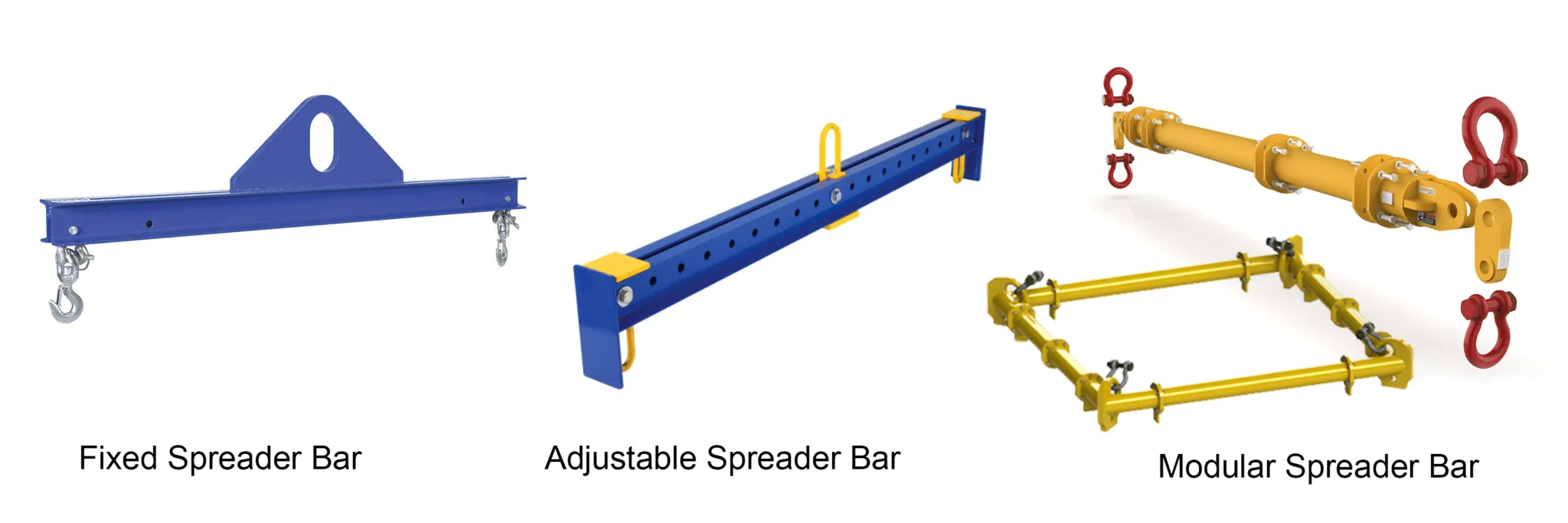Spreader Bars in Rigging: The Backbone of Efficient Lifting Operations
Spreader Bars in Rigging: The Backbone of Efficient Lifting Operations
In the intricate world of rigging, where the precision and safety of lifting operations are paramount, spreader bars emerge as unsung heroes. These simple yet indispensable tools play a pivotal role in distributing loads, maintaining balance, and ensuring the safety of both personnel and equipment. In this blog, we dive into the world of spreader bars, unraveling their design, applications, and the crucial role they play in enhancing efficiency and safety in rigging operations.
I. Understanding Spreader Bars:
At its essence, a spreader bar is a horizontal device designed to evenly distribute the load of a lifted object, creating a stable and controlled lifting environment. These bars consist of a beam or pipe with attachment points for slings or lifting gear at each end, facilitating a secure connection to the load. Spreader bars come in various sizes and configurations, allowing for adaptability to different lifting scenarios.
Technical Aspect: The design of a spreader bar is carefully calculated to ensure proper weight distribution, prevent load imbalance, and reduce stress on lifting equipment. This is achieved through engineering principles that consider factors such as load weight, dimensions, and center of gravity.
II. Applications of Spreader Bars in Rigging:
- Heavy Equipment Lifting: Spreader bars are commonly employed in lifting heavy equipment and machinery. By providing a balanced and controlled lifting point, these bars contribute to the safe and efficient transport of oversized or irregularly shaped loads.
- Case Study: In the construction industry, spreader bars are frequently used to lift and position prefabricated elements, such as large concrete panels or steel structures, minimizing the risk of load shifting during the lifting process.
- Marine Rigging: The maritime industry relies heavily on spreader bars for lifting and positioning loads on ships. Whether loading cargo onto vessels or conducting maintenance on maritime structures, spreader bars ensure stable and secure lifting operations.
- Technical Aspect: In marine applications, spreader bars may be equipped with additional features such as corrosion-resistant coatings or materials to withstand the harsh maritime environment.
- Container Lifting: Spreader bars play a crucial role in container lifting operations, particularly in ports and logistics hubs. Their ability to evenly distribute the weight of shipping containers ensures safe and efficient loading and unloading processes.
- Interesting Fact #1: Some spreader bars are designed to lift multiple containers simultaneously, optimizing container handling efficiency in busy port environments.
III. Types of Spreader Bars:
- Fixed Spreader Bars: These are rigid bars with fixed attachment points for slings or lifting gear. Fixed spreader bars are ideal for straightforward lifting operations where the load is stable and uniform.
- Technical Aspect: The fixed design minimizes the complexity of the spreader bar, making it a cost-effective and straightforward solution for many lifting scenarios.
- Adjustable Spreader Bars: Offering versatility, adjustable spreader bars allow for the adjustment of the attachment points along the length of the bar. This adaptability makes them suitable for lifting irregularly shaped loads.
- Case Study: In the entertainment industry, adjustable spreader bars are often used to lift stage equipment and lighting rigs with varying shapes and sizes.
- Modular Spreader Bars: Modular spreader bars consist of individual components that can be assembled or disassembled, providing flexibility in terms of length and configuration.
- Interesting Fact #2: Some modular spreader bars are designed to be collapsible for easy transportation and storage, offering practicality in diverse rigging environments.

IV. Safety Considerations in Spreader Bar Usage:
- Load Calculation: Proper load calculation is paramount when using spreader bars. Rigging professionals must consider the weight, dimensions, and center of gravity of the load to ensure that the spreader bar is appropriately sized for the task.
- Technical Aspect: Load charts and engineering calculations are often utilized to determine the optimal spreader bar configuration for a given lifting operation.
- Inspection and Maintenance: Regular inspection and maintenance of spreader bars are critical for ensuring their continued reliability and safety. Any signs of wear, corrosion, or structural damage must be addressed promptly.
- Case Study: In the oil and gas industry, where heavy loads are lifted offshore, spreader bars undergo rigorous inspection and maintenance protocols to comply with strict safety standards.
- Training and Certification: Rigging professionals responsible for the operation of spreader bars should undergo specialized training to understand the principles of safe usage and maintenance.
- Interesting Fact #3: Some industries require certifications or qualifications for rigging personnel to operate specific types of spreader bars, ensuring a high level of competence in their usage.
V. Advancements in Spreader Bar Technology:
- Smart Rigging Technology: The integration of sensors and monitoring devices into spreader bars is a growing trend in the industry. These smart spreader bars provide real-time data on load distribution, helping operators make informed decisions during lifting operations.
- Technical Aspect: Smart rigging technology enhances safety by providing immediate feedback on load conditions, reducing the risk of overloading or imbalances.
- Material Innovations: Advancements in material science have led to the development of lightweight yet durable materials for spreader bars. This not only reduces the overall weight of the rigging equipment but also enhances its portability and longevity.
- Case Study: Aerospace industries utilize lightweight composite materials in spreader bars for lifting delicate components during the manufacturing and assembly of aircraft.
VI. Environmental Considerations and Sustainability:
In the modern era, where sustainability is a key focus, rigging industries are exploring eco-friendly materials and manufacturing processes for spreader bars. This shift aligns with the broader trend towards greener practices in construction and industrial operations.
Interesting Fact #4: Some companies are investing in recyclable materials for spreader bars, contributing to a more sustainable and environmentally conscious approach in rigging operations.
Wrapping it up:
Spreader bars, often overshadowed by the massive structures they help lift, are the unsung heroes of rigging operations. From heavy equipment lifting to maritime rigging and container handling, these simple yet sophisticated devices play a crucial role in ensuring the safety, efficiency, and success of lifting endeavors. As technology advances, spreader bars are evolving to meet the demands of modern industries, incorporating smart features, lightweight materials, and sustainable practices. In the ever-evolving landscape of rigging, spreader bars remain the backbone, distributing the weight of progress with precision and reliability.
——————————————————————————————————————————————
The Hercules Group of Companies encompasses a wide portfolio of products and services across 7 diverse companies.


